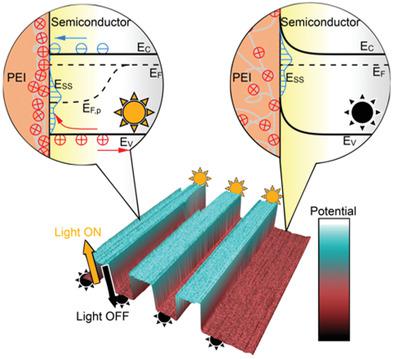Our official English website, www.x-mol.net, welcomes your
feedback! (Note: you will need to create a separate account there.)
Light‐Promoted Electrostatic Adsorption of High‐Density Lewis Base Monolayers as Passivating Electron‐Selective Contacts
Advanced Science ( IF 14.3 ) Pub Date : 2021-01-04 , DOI: 10.1002/advs.202003245 Xi Yang 1 , Zhiqin Ying 1, 2 , Zhenhai Yang 1 , Jia-Ru Xu 3 , Wei Wang 1 , Jiajia Wang 1 , Zenggui Wang 1 , Lingze Yao 1 , Baojie Yan 1 , Jichun Ye 1
Advanced Science ( IF 14.3 ) Pub Date : 2021-01-04 , DOI: 10.1002/advs.202003245 Xi Yang 1 , Zhiqin Ying 1, 2 , Zhenhai Yang 1 , Jia-Ru Xu 3 , Wei Wang 1 , Jiajia Wang 1 , Zenggui Wang 1 , Lingze Yao 1 , Baojie Yan 1 , Jichun Ye 1
Affiliation

|
Achieving efficient passivating carrier‐selective contacts (PCSCs) plays a critical role in high‐performance photovoltaic devices. However, it is still challenging to achieve both an efficient carrier selectivity and high‐level passivation in a sole interlayer due to the thickness dependence of contact resistivity and passivation quality. Herein, a light‐promoted adsorption method is demonstrated to establish high‐density Lewis base polyethylenimine (PEI) monolayers as promising PCSCs. The promoted adsorption is attributed to the enhanced electrostatic interaction between PEI and semiconductor induced by the photo‐generated carriers. The derived angstrom‐scale PEI monolayer is demonstrated to simultaneously provide a low‐resistance electrical contact for electrons, a high‐level field‐effect passivation to semiconductor surface and an enhanced interfacial dipole formation at contact interface. By implementing this light‐promoted adsorbed PEI as a single‐layered PCSC for n‐type silicon solar cell, an efficiency of 19.5% with an open‐circuit voltage of 0.641 V and a high fill factor of 80.7% is achieved, which is one of the best results for devices with solution‐processed electron‐selective contacts. This work not only demonstrates a generic method to develop efficient PCSCs for solar cells but also provides a convenient strategy for the deposition of highly uniform, dense, and ultra‐thin coatings for diverse applications.
中文翻译:

高密度路易斯碱单分子层的光促进静电吸附作为钝化电子选择性接触
实现高效钝化载流子选择性接触(PCSC)在高性能光伏器件中起着至关重要的作用。然而,由于接触电阻率和钝化质量的厚度依赖性,在单一中间层中实现有效的载流子选择性和高水平的钝化仍然具有挑战性。在此,证明了光促进吸附方法可以建立高密度路易斯碱聚乙烯亚胺(PEI)单层作为有前途的 PCSC。促进的吸附归因于光生载流子诱导的 PEI 和半导体之间增强的静电相互作用。所衍生的埃级 PEI 单层被证明可以同时为电子提供低电阻电接触、对半导体表面的高水平场效应钝化以及在接触界面处增强的界面偶极子形成。通过将这种光促吸附 PEI 作为n型硅太阳能电池的单层 PCSC,实现了 19.5% 的效率、0.641 V 的开路电压和 80.7% 的高填充因子,这是一个具有溶液处理电子选择性接触的器件的最佳结果。这项工作不仅展示了一种开发用于太阳能电池的高效 PCSC 的通用方法,而且还为沉积用于不同应用的高度均匀、致密和超薄涂层提供了一种便捷的策略。
更新日期:2021-03-03
中文翻译:

高密度路易斯碱单分子层的光促进静电吸附作为钝化电子选择性接触
实现高效钝化载流子选择性接触(PCSC)在高性能光伏器件中起着至关重要的作用。然而,由于接触电阻率和钝化质量的厚度依赖性,在单一中间层中实现有效的载流子选择性和高水平的钝化仍然具有挑战性。在此,证明了光促进吸附方法可以建立高密度路易斯碱聚乙烯亚胺(PEI)单层作为有前途的 PCSC。促进的吸附归因于光生载流子诱导的 PEI 和半导体之间增强的静电相互作用。所衍生的埃级 PEI 单层被证明可以同时为电子提供低电阻电接触、对半导体表面的高水平场效应钝化以及在接触界面处增强的界面偶极子形成。通过将这种光促吸附 PEI 作为n型硅太阳能电池的单层 PCSC,实现了 19.5% 的效率、0.641 V 的开路电压和 80.7% 的高填充因子,这是一个具有溶液处理电子选择性接触的器件的最佳结果。这项工作不仅展示了一种开发用于太阳能电池的高效 PCSC 的通用方法,而且还为沉积用于不同应用的高度均匀、致密和超薄涂层提供了一种便捷的策略。































 京公网安备 11010802027423号
京公网安备 11010802027423号